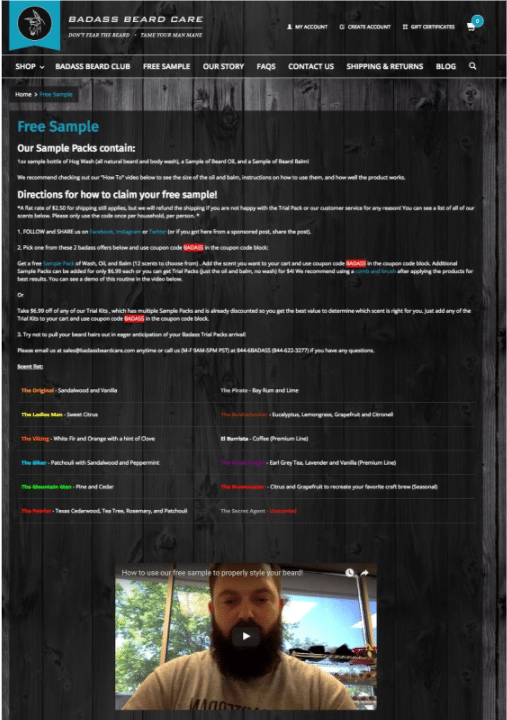Peak Season Conversion Rate Optimization Guide for Your Online Shop
This is a guest post from our partner BigCommerce.
The holiday season is both loathed and loved by retailers across the globe. Nail your holiday strategy, and you’ll set yourself up for a strong next year with both increased revenue as well as customers to nurture back to repeat buyers.
The second part of that equation is arguably the most important. In an eCommerce industry where it’s cheaper to nurture existing customers to repeat purchase than it is to find net new customers –– it is essential that you use the holiday season to capture buyers so you can nurture them to brand loyalty in the new year.
This means that your focus between now and the start of the holiday needs to be conversion rate optimization. You need more people on your site converting to customers, more often and –– more quickly.
Here are 13 ways to make sure that happens. But first…
What is a good eCommerce conversion rate?
Average eCommerce conversion rates are 1% – 2%. Even if you are doing everything right, you can still expect to win the sale around 2% of the time.
A 2%+ conversion rate should be the baseline goal for your online store – especially during the holiday season.
1. Find Your Conversion Issue Areas
There are quite a few invaluable and very useful tools to help analyze your current conversion rate issues on the market. The following five are considered the most valuable.
Inspectlet
This is an amazing tool that will let you record every move your visitors make on your website. It will show you the user’s IP Address, location started page, where they came from and how long they stayed.
Simply sign up for an account and put a script tag on your site to start the session recording process. There is a free version that allows you 100 recorded sessions per month if you just want to get a feel for what your users are doing.
Just add a script tag to your website and then login to your Inspectlet account. Click on a session to see the recording of each user’s interactivity on your website.
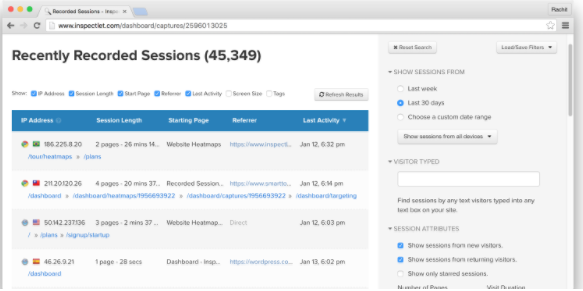
Mixpanel
Mixpanel allows you to view your website visitors’ actions by placing event catching tags on various elements of your ecommerce website. This will not record like Inspectlet does, but it will give you a very detailed snapshot of what is happening based on where users click, how many times, etc.
This will help you determine how useful certain form fields are or how important certain sections of your website are to users. You can also setup A/B testing to determine which layouts and fields convert better.

CrazyEgg
CrazyEgg is an eye tracking tool that lets you see where users are scrolling and interacting based on heatmaps, scrollmaps and overlay tools.
The confetti type view in crazyegg will show you everywhere users have clicked on your landing page and the colors signify greater or fewer clicks. Heatmap analysis helps you understand what users do once they get to your site, oftentimes unveiling opportunities to make certain aspects of a page easier to navigate.

Google Analytics and Webmaster Tools
Google Analytics gives you a great view into your website visitors including:
- How visitors found your website: This could be from keyword searches in google, referral websites or direct visits.
- How long visitors stay on your website
- Where the visitors are from
- If the visitors are returning or new
- What browser, operating system and if the visitor used a mobile device or desktop/laptop
- How many visitors converted (based on goals setup) and the interaction that lead to the conversion
- Link to your Google Adwords campaign to track paid traffic as well
BigCommerce Ecommerce Analytics
If you have your store running on BigCommerce, the platform has an Analytics section in the administration panel that shows all abandoned carts including what products were in the cart at the time of abandonment.
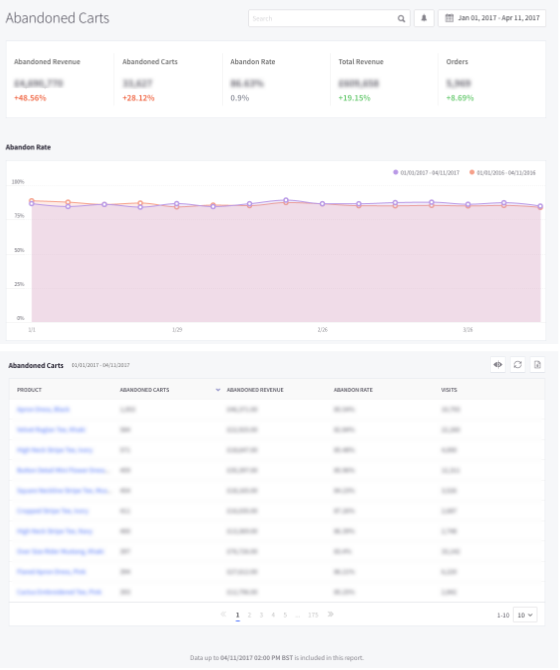
There are also analytics on In-Store Searches that will show you what customers are typing into the built-in BigCommerce search tool. This underutilized conversion optimization tactic helps you bridge the gap between what your customers are looking for and your on-site language and content.

Look at keywords your potential customers are searching for that *are not* showing up. This can help you determine what you need to add into the store, for example.

BigCommerce’s Ecommerce Analytics has multiple other Analytics dashboard, but they are most useful when you have customers. The two above will help you diagnose conversion problems without customers.
There are a few other great tools out there, but this should be more than enough to get visitor interaction information to figure out where your website is lacking or excelling in regards to conversion rates.
2. Use high quality product images
Think about what you want to see when you are shopping. When you are shopping online you can’t touch the product or put it on. The best thing you can do is to show as detailed an image as possible so that the customer knows exactly what they are getting. Use as high quality images as possible depending on how close you want customers to zoom into the image. Here’s a great guide to get you started.
3. Offer Free Shipping
Everyone likes to think they are getting a deal. Offering free shipping makes customers feel like they are getting some sort of deal even if they aren’t.
Think you can’t offer free shipping? Keep in mind that this is often a psychological game. Increase your product prices to cover shipping cost if that’s what needs to be done.
4. Use Coupon Codes
Create coupon codes that customers can use at checkout to get a specific amount off or a percentage of the purchase.

5. Tweak your ecommerce checkout process
If your store checkout process is too long, complicated or unconventional, you may lose a lot of customers right as they are ready to buy. This crucial step in the funnel is where a lot of your split testing, A/B tests and site tweaks should take place.
Of course, there are industry standards for most hosted eCommerce platforms such as BigCommerce, but you may still need to tweak the process based on your customers.
For example, BigCommerce offers an optimized checkout out-of-the-box that is technically a single page (with a few drop downs and a persistent view of the product(s) being bought).
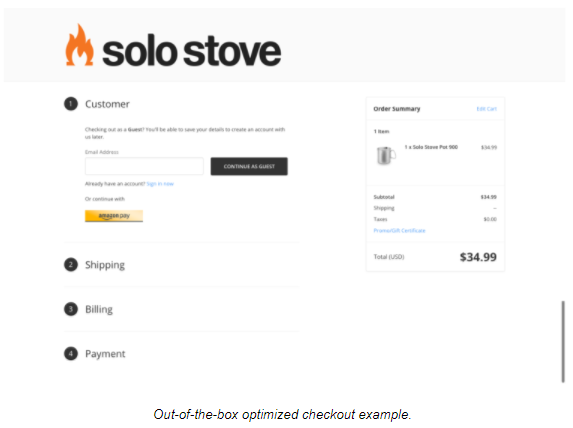
Some brands like to take this even further and build off that optimized checkout to create a true one-page checkout where you can see the entire checkout process when you land on the page.
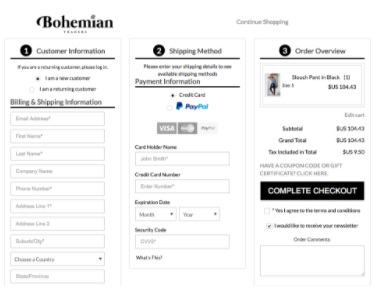
6. Use cart abandonment software
If you are getting a lot of abandoned carts –– i.e. Someone lands on your site, puts an item in the cart and then leaves –– then abandoned cart software can greatly increase your store conversion rates.
This software works with users that have added items to their shopping cart, entered their email and details and then left your store. Some ecommerce platforms offer this software free as part of the store functionality.
Here’s an example of the first email from a BigCommerce customer after an abandoned cart.
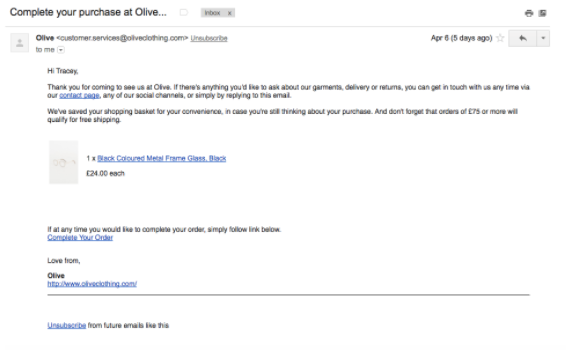
That software allows you to create follow-up emails that will send the user an email with their cart contents as well as allow you to give them a coupon code to get a discount as an incentive to complete their order.
Decreasing abandonment rate should be a high priority for online store owners, since this cohort of users have demonstrated interest — and abandonment is often between 60 and 80%.

The success of this software is different for every store, but there is no doubt that it helps pretty much 100% of eCommerce stores that use it. Some stores see as much as a 30% increase in their website conversion rates. Acting on cart abandonment by itself can take you from low to average conversion rate.
7. Let customers know your eCommerce store is safe
This is subtle, but a really big deal. You need to build a certain level of trust in a short amount of time for customers to be willing to enter their credit card information on your website. Split tests have shown that trust signals can significantly increase conversion — so don’t miss out.
Finding ways to enhance your on-site trust and credibility should be the basis for many of your conversion rate optimization activities.
Customers want to know that they are dealing with a legitimate store that has industry standard security measures in place that ensures them their credit card information will be protected. Here are a few things that help:
- Install SSL at checkout (out-of-the-box on most ecommerce platforms) and site wide if possible.
- Show small images of credit cards, PayPal and other payment options as a visual signal that you use customer-trust payment options.
- Display some sort of McAfee, GeoTrust or other security badges, and make sure that you actually have an active account with them. Don’t just add an image if you aren’t truly secure.
8. Setup structure so visitors can easily find products
Structure your product categories in a logical manner, but make sure you use as few levels as possible to allow a user to reach a product as fast as possible.

I simplified mine like the above. Oftentimes, it is also necessary to allow customers to Shop by Color or other various fields.
Setup a rotating banner to showcase top products. Here is an example from Trust the Bum.
 Rotating image 1
Rotating image 1

Also, implement a website search to allow customers to find products easily. The faster a visitor can find a product, the more likely they are to buy from you.
9. Make your checkout form easy to understand
Make sure that everything on your checkout form is completely understood, such as CVV and input formats. In fact, if you can, I would have the fields limit only what can be typed into certain fields to make it easier for users.
So, when a user types a credit card number, format it for them as they go along to make it easier to read and harder to mess up.
In a date field, don’t let the user type, but have a date picker or dropdown.
The user is already reluctant to enter their personal credit/debit card info already. Don’t give them any reason to feel uncomfortable or make it hard for them to check out.
Digital wallets help tremendously with this. Digital wallets are payment processors like PayPal Express, Amazon Pay, Apple Pay, and others. These systems allow users to sign in with their account information and then pre-populates everything for them. It is faster for them, and more secure for everyone.
10. Let customers checkout as guests
Allow users to checkout without signing up for an account. You will have their name and email address when they buy anyway. Forcing the user to register is just giving them another reason to leave your store.

11. Have a great product return policy
Most customers (over 50%) will read the return policy before buying. Don’t over-promise here, but definitely make it as painless and as easy as possible for customers to return products (within reason). This may not sound like conversion optimization, but is another example of basic business practices acting as CRO.
12. Try and catch customers before they leave
Once a customer leaves, they are most likely going to buy from somewhere else.
While I hate pop ups as much as the next guy, the last chance you have to catch a potential customer is the moment they are trying to exit your website.
You can use software such as MaxTraffic, OptiMonk, Sleeknote, Sumome or OptinMonster. Your goal here is to collect an email and drive your subscription base. Your subscription base (whether they are customers or not) are people you do not have to spend money on to advertise or market to –– because you can send them an email, instead. You want that list to be as large and engaged (i.e. actively opening the emails) as possible.
13. Use a tripwire offer
A tripwire is a low-cost almost undeniable deal to get a visitor to purchase from you.
This does two things:
- First, it allows you to “get the money flowing” as perfected by American Pickers. This builds trust.
- The second thing it does is allow you to offer a higher priced / upsell to the current customer. You can now approach them as a customer and treat them as such. Give them special treatment and offer them something they cannot get as a normal visitor. This is just a longer process of building trust. You can also use this as a way to grow your ecommerce email list, which allows you to sell to the list at any time even if you don’t try and sell them something immediately.
The Badass Beard Care team has done this perfectly. They offer a free sample of the product in an ad on Facebook. The customer only pays for shipping. This gets the product in the customer’s hand, and gets that customer’s information to the marketing gurus at Badass Beard Care.
Final Word
The very first step to optimizing your site for sales is making sure that folks can check out. After that, it’s crucial that you use the tools available to you to see how people are actually using your site (versus how you thought they were) and then make small, incremental changes to increase sales based on data.
And finally, be kind. Offer people value in the form of content, conversation or free samples. This will increase trust in your site, bring people into your funnel and ultimately make them brand advocates long after the holiday season.
TRACEY WALLACE IS THE EDITOR-IN-CHIEF AT BIGCOMMERCE, WHERE SHE COVERS ALL THINGS ECOMMERCE: MARKETING, DESIGN, DEVELOPMENT, STRATEGY, PLUS EMERGING TRENDS, INCLUDING OMNICHANNEL AND CLOUD REPLATFORMING.
SHE IS OFTEN FEATURED IN PUBLICATIONS, SUCH AS FORBES, ENTREPRENEUR, MASHABLE, AND ELLE, ALONG WITH LEADING BIGCOMMERCE PARTNERS LIKE HUBSPOT AND SQUARE.
SHE LAUNCHED HER CAREER IN ECOMMERCE WITH Y-COMBINATOR BACKED SHOPTIQUES.
